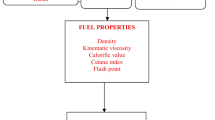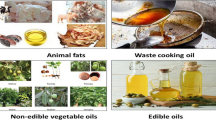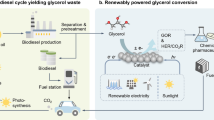Abstract
Substitution of fossil feedstock by vegetable oils is growing due to environmental constraints and oil depletion. Among the different valorization routes for vegetable oils, epoxidation of their unsaturation is widely used. The epoxidation is an exothermic reaction which could lead to a thermal runaway. There are different routes for the vegetable oil epoxidation: Prileschajew by performic and peracetic acid, which are the most used. Another promising alternative is the direct epoxidation by hydrogen peroxide by alumina. The goal of this manuscript is to rank the thermal risk of these three epoxidation routes by determining the safety parameter time to maximum rate under adiabatic condition. The Advanced Reactive System Screening Tool was used to conduct these experiments. It was found that the direct epoxidation is safer than the two other routes.









Similar content being viewed by others
Abbreviations
- \(\hat{C}_{{{\text{P}}_{\text{R}} }}\) :
-
Specific heat capacity (J kg−1 K−1)
- E a :
-
Activation energy (J mol−1)
- ΔH :
-
Reaction enthalpy (J mol−1)
- m R :
-
Mass of reaction mixture (kg)
- q el :
-
Electrical heating rate (°C min−1)
- q r :
-
Heat flow rate due to chemical reactions (J s−1)
- R :
-
Gas constant (J K−1 mol−1)
- ΔTad :
-
Adiabatic temperature rise (°C)
- T 1 :
-
Temperature of the reaction mixture (°C)
- T Ref :
-
Reference temperature (°C)
- \(T_{\text{i}}\) :
-
Experimental temperature
- \(T_{\text{P}}\) :
-
Process temperature
- V :
-
Volume (L)
- β :
-
Background heating rate (°C min−1)
- AA:
-
Acetic acid
- ARSST:
-
Advanced Reactive System Screening Tool
- CA:
-
Carboxylic acid
- DB:
-
Double bond
- FA:
-
Formic acid
- HP:
-
Hydrogen peroxide
- TMRad(TP):
-
Time to maximum rate under adiabatic conditions at TP (min)
- W :
-
Water
- aq:
-
Aqueous
- Ep:
-
Epoxidation
- ins:
-
Insert
- R :
-
Reaction
- org:
-
Organic
- perh:
-
Perhydrolysis
- T :
-
Total
- 0:
-
Initial
References
Fukuda H, Kondo A, Noda H. Biodiesel fuel production by transesterification of oils. J Biosci Bioeng. 2001;92:405–16.
Körbitz W. Biodiesel production in Europe and North America, an encouraging prospect. Renew Energy. 1999;16:1078–83.
Leung DYC, Wu X, Leung MKH. A review on biodiesel production using catalyzed transesterification. Appl Energy. 2010;87:1083–95.
Santacesaria E, Vicente GM, Di Serio M, Tesser R. Main technologies in biodiesel production: state of the art and future challenges. Catal Today. 2012;195:2–13.
Di Serio M, Tesser R, Pengmei L, Santacesaria E. Heterogeneous catalysts for biodiesel production. Energy Fuels. 2008;22:207–17.
Danov SM, Kazantsev OA, Esipovich AL, Belousov AS, Rogozhin AE, Kanakov EA. Recent advances in the field of selective epoxidation of vegetable oils and their derivatives: a review and perspective. Catal Sci Technol. 2017;7:3659–75.
Cai X, Zheng JL, Wärnå J, Salmi T, Taouk B, Leveneur S. Influence of gas-liquid mass transfer on kinetic modeling: carbonation of epoxidized vegetable oils. Chem Eng J. 2017;313:1168–83.
Zheng JL, Burel F, Salmi T, Taouk B, Leveneur S. Carbonation of vegetable oils: influence of mass transfer on reaction kinetics. Ind Eng Chem Res. 2015;54:10935–44.
Pérez-Sena WY, Cai X, Kebir N, Vernières-Hassimi L, Serra C, Salmi T, et al. Aminolysis of cyclic-carbonate vegetable oils as a non-isocyanate route for the synthesis of polyurethane: a kinetic and thermal study. Chem Eng J. 2018;346:271–80.
Sawpan MA. Polyurethanes from vegetable oils and applications: a review. J Polym Res. 2018;25:184.
Köckritz A, Martin A. Oxidation of unsaturated fatty acid derivatives and vegetable oils. Eur J Lipid Sci Technol. 2008;110:812–24.
Abraham ME, Benenati RF. Kinetics and mechanism of the epoxidation of unsaturated fatty acids. AIChE J. 1972;18:807–11.
Prileschajew N. Oxydation ungesättigter Verbindungen mittels organischer Superoxyde. Ber Deutsch Chem Ges. 1909;42:4811–5.
Rangarajan B, Havey A, Grulke EA, Culnan PD. Kinetic parameters of a two-phase model for in situ epoxidation of soybean oil. J Am Oil Chem Soc. 1995;72:1161–9.
Wisniak J, Navarrete E. Epoxidation of fish oil, kinetic and optimization model. Prod R&D. 1970;9:33–41.
Wisniak J, Cancino A, Vega JC. Epoxidation of anchovy oils. a study of variables. I&EC Prod Res Dev. 1964;3:306–11.
Zheng JL, Wärnå J, Salmi T, Burel F, Taouk B, Leveneur S. Kinetic modeling strategy for an exothermic multiphase reactor system: application to vegetable oils epoxidation using Prileschajew method. AIChE J. 2016;62:726–41.
Santacesaria E, Tesser R, Di Serio M, Turco R, Russo V, Verde D. A biphasic model describing soybean oil epoxidation with H2O2 in a fed-batch reactor. Chem Eng J. 2011;173:198–209.
Cai X, Zheng JL, Aguilera AF, Vernières-Hassimi L, Tolvanen P, Salmi T, et al. Influence of ring-opening reactions on the kinetics of cottonseed oil epoxidation. Int J Chem Kinet. 2018;50:726–41.
Leveneur S. Thermal safety assessment through the concept of structure–reactivity: application to vegetable oil valorization. Org Process Res Dev. 2017;21:543–50.
Leveneur S, Pinchard M, Rimbault A, Safdari Shadloo M, Meyer T. Parameters affecting thermal risk through a kinetic model under adiabatic condition: application to liquid-liquid reaction system. Thermochim Acta. 2018;666:10–7.
Leveneur S, Estel L, Crua C. Thermal risk assessment of vegetable oil epoxidation. J Therm Anal Calorim. 2015;122:795–804.
de Quadros JV Jr., Giudici R. Epoxidation of soybean oil at maximum heat removal and single addition of all reactants. Chem Eng Process Process Intensif. 2016;100:87–93.
Vianello C, Piccolo D, Lorenzetti A, Salzano E, Maschio G. Study of soybean oil epoxidation: effects of sulfuric acid and the mixing program. Ind Eng Chem Res. 2018;57:11517–25.
Vianello C, Salzano E, Maschio G. Thermal behaviour of peracetic acid for the epoxydation of vegetable oils in the presence of catalyst. Process Saf Environ Prot. 2018;116:718–26.
Casson Moreno V, Russo V, Tesser R, Di Serio M, Salzano E. Thermal risk in semi-batch reactors: the epoxidation of soybean oil. Process Saf Environ Prot. 2017;109:529–37.
Dakkoune A, Vernières-Hassimi L, Leveneur S, Lefebvre D, Estel L. Risk analysis of French chemical industry. Saf Sci. 2018;105:77–85.
Scotti N, Ravasio N, Psaro R, Evangelisti C, Dworakowska S, Bogdal D, et al. Copper mediated epoxidation of high oleic natural oils with a cumene—O2 system. Catal Commun. 2015;64:80–5.
Sepulveda J, Teixeira S, Schuchardt U. Alumina-catalyzed epoxidation of unsaturated fatty esters with hydrogen peroxide. Appl Catal A Gen. 2007;318:213–7.
Di Serio M, Turco R, Pernice P, Aronne A, Sannino F, Santacesaria E. Valuation of Nb2O5–SiO2 catalysts in soybean oil epoxidation. Catal Today. 2012;192:112–6.
Turco R, Pischetola C, Tesser R, Andini S, Serio MD. New findings on soybean and methylester epoxidation with alumina as the catalyst. RSC Adv. 2016;6:31647–52.
Parada Hernandez NL, Bonon AJ, Bahú JO, Barbosa MIR, Wolf Maciel MR, Filho RM. Epoxy monomers obtained from castor oil using a toxicity-free catalytic system. J Mol Catal A: Chem. 2017;426:550–6.
Koskinen H, Leveneur S, Sundquist A, Musakka N, Salmi T, Renvall I. Functionality of poly(α-hydroxyacrylic acid) as H2O2 stabilizing agent. Oxid Commun. 2010;2:258–74.
Stoessel F. Thermal safety of chemical processes. Weinheim: Wiley-VCH Verlag GmbH & Co. KGaA; 2008.
Leveneur S, Vernieres-Hassimi L, Salmi T. Mass and energy balances coupling in chemical reactors for a better understanding of thermal safety. Educ Chem Eng. 2016;16:17–28.
Marco E, Cuartielles S, Peña JA, Santamaria J. Simulation of the decomposition of di-cumyl peroxide in an ARSST unit. Thermochim Acta. 2000;362:49–58.
Fauske HK. Managing chemical reactivity—Minimum best practice. Process Saf Prog. 2006;25:120–9.
Burelbach JP. Advanced reactive system screening tool (ARSST). In: 28th Annual conference North American, Thermal Analysis Society (NATAS), Orlando, Oct 4–6, 2000.
Zhu W, Papadaki MI, Han Z, Mashuga CV. Effect of temperature and selected additives on the decomposition “onset” of 2-nitrotoluene using advanced reactive system screening tool. J Loss Prev Process Ind. 2017;49:630–5.
Tang W, Sarvestani M, Wei X, Nummy LJ, Patel N, Narayanan B, et al. Formation of 2-trifluoromethylphenyl grignard reagent via magnesium − halogen exchange: process safety evaluation and concentration effect. Org Process Res Dev. 2009;13:1426–30.
Fogler HS. Elements of chemical reaction engineering. Upper Saddle River: Prentice Hall Inc; 1999.
KamalaJyotsna G, Srikanth S, Ratnaparkhi V, Ichhora BR. Reaction calorimetry as a tool for thermal risk assessment and improvement of safe scalable chemical processes. Inorg Chem Indian J. 2017;12:1–14.
Salem IA, Salem MA, Gemeay AH. Kinetics of heterogeneous decomposition of hydrogen peroxide with some transition metal complexes supported on silica-alumina in aqueous medium. J Mol Catal. 1993;84:67–75.
Acknowledgements
This study has been done in the framework of Task 2: “Green process: second generation of biomass” of AMED project. The authors thank AMED project. The AMED project has been funded with the support from the European Union with the European Regional Development Fund (ERDF) and from the Regional Council of Normandie. The authors thank the Ministry of High Education, Science and Technology of Dominican Republic (MESCyT).
Author information
Authors and Affiliations
Corresponding author
Additional information
Publisher's Note
Springer Nature remains neutral with regard to jurisdictional claims in published maps and institutional affiliations.
Rights and permissions
About this article
Cite this article
Pérez-Sena, W.Y., Salmi, T., Estel, L. et al. Thermal risk assessment for the epoxidation of linseed oil by classical Prisleschajew epoxidation and by direct epoxidation by H2O2 on alumina. J Therm Anal Calorim 140, 673–684 (2020). https://doi.org/10.1007/s10973-019-08894-2
Received:
Accepted:
Published:
Issue Date:
DOI: https://doi.org/10.1007/s10973-019-08894-2




